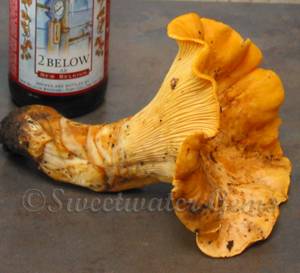Food
Chanterelle Mushroms

Chanterelle Mushroms
We are amazingly lucky to have Chanterelles growing on the property. We have had a year which saw probably 20 pounds of the lovely yellow mushrooms on our table followed by a year that yielded not one mushroom. The season is sporatic and directly corresponds to the rainfall - about 3 days after the rains let up Steve will wander out with a wicker basket, a good sharp knife, a small rake to uncover "shrumps", a little brush to field clean the mushrooms and some paper towels for cushioning the crop and hand cleaning. If we get a lot of rain we seem to get more of the golden trumpets but the downside is that they can be very very dirty.
Chanterelles can be held for several days before using. Place them on papertowels in a basket and cover with a cloth towel. They will lose some of their moisture every day so it's advisable to use them within a few days.
We recommend consulting David Arora's "Mushrooms Demystified" before ever consuming any mushroom that you find wild in the woods - people die every year from mushroom poisoning. Chanterelles are easy to identify however, and the only other variety that is similar (and grows around here) isn't fatal, just very unpleasant. We wouldn't ever eat any of the other varieties of mushrooms that grow here (including Boletes and Cocora) without being absolutely certain of their authenticity. I like mushrooms, but not enough to risk illness or death.
Cleaning Chanterelles:
Chanterelles have a very high moisture content and are heavy and full of water when they are fresh. Unlike other mushrooms, they can be washed under running water without damaging them at all. I still minimize the washing, but I do make sure and get them clean and check for "holes" in the stems that indicate they might have bugs. The bugs have been few and it is easy to spot them. I usually cut off the bottom of the mushroom and cut away any clumps of dirt before washing them. After they are washed, let them drain and then put on papertowels to absorb any moisture that might come out.
They can be sliced, however, I usually just break them apart with my hands - they peel like string cheese the whole length of the stem and through the cap. It makes a pleasant wedge shaped piece. They chop fine also if you want to use them for a mirepoix but it will take an extra bit of cooking to get all the moisture out before you can proceed with your recipe.
De-Moisturizing and Cooking Chanterelles:
Before you use Chanterelles in a recipe you will want to remove as much of the moisture as possible through evaporation.
Heat a large cast iron skillet on medium-high heat. When pan is hot add mushrooms that have been sliced or pulled apart or chopped, whatever you prefer for your intended use. Almost immediately mushrooms will start to sweat and an amazing amount of water will flood the pan. Keep the pan on pretty high until all the moisture evaporates and the pan gets dry. You can also dump the water out if you don't want to wait. After the pan is dry, turn the heat down to medium-low and cook a few minutes, adding butter or olive oil and salt to the pan to serve as is, or, at this point they can be used in other recipes.
The first time someone cooked them for us they were almost carmelized and the flavor was good and rather intense.

Here's some toasted french bread with melted cheese, sauteed Chanterelles, and miners lettuce. Yum!
We also like them a lot in pasta or on hamburgers.